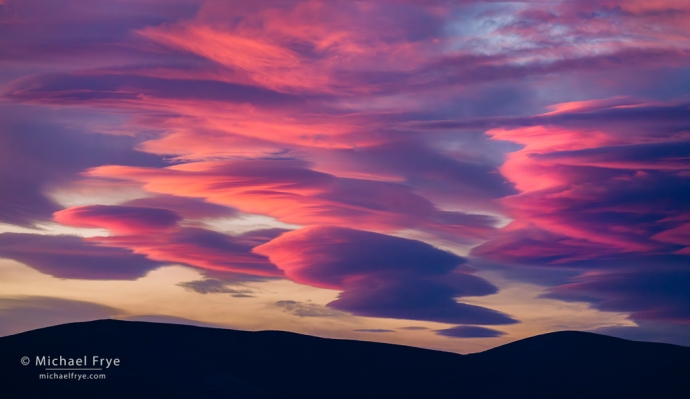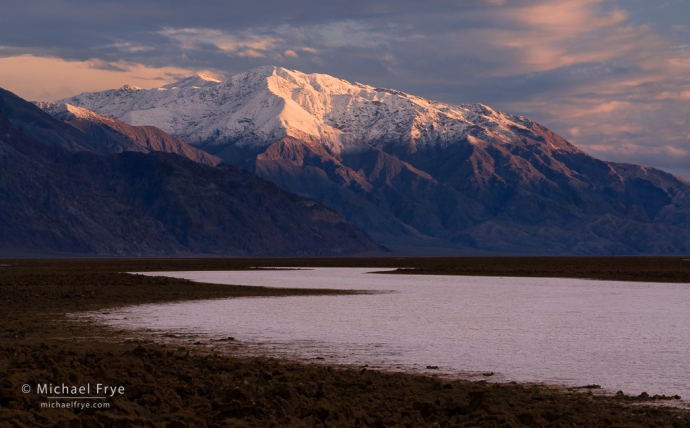Light and Weather
by Michael Frye | Jul 2, 2023 | Light and Weather

Lenticular clouds at sunset, eastern Sierra Nevada, California
I don’t know many landscape photographers who like wind. Wind gyrates flowers and trees, making it hard to get sharp photos. It ruffles lakes, killing reflections. Wind can even shake a tripod-mounted camera, blurring images (especially with telephoto lenses). And it’s generally unpleasant to be out in the wind – especially when it’s cold.
But sometimes wind creates interesting opportunities. On the leeward side of a mountain range (usually the eastern side), or on isolated mountain peaks, wind often creates lenticular clouds, which can be incredibly beautiful and photogenic.
(more…)
by Michael Frye | Jun 25, 2023 | Light and Weather, Vision and Creativity

Redwoods, ferns, and rhododendrons, northern California coast. I’ve photographed sun breaking through fog in redwood forests many times, but it’s always a special treat. At this particular moment the sun highlighted the redwood trunk on the left, providing a visual focal point, with the ferns, rhododendrons, other trunks, and patches of sunlight all arranging themselves in a harmonious way. I consciously planted the tripod at a spot where I could see decent spacing and separation between the trunks.
Claudia and I have been traveling a lot this year, with trips to Mono Lake, Zion, Valley of Fire, Anza-Borrego and the Central Coast ranges for flowers, the Olympic Peninsula, and multiple visits to Death Valley – along with day trips to Yosemite, of course.
And recently we made another trip, this time to the northern California redwoods for our annual workshop there. But even though that was a long drive, it seemed like we were coming home, rather than leaving home. I always feel that way when we return to the redwoods, because I love that area so much.
(more…)
by Michael Frye | Mar 26, 2023 | Light and Weather, Travels and Stories

Cottonwood in snow, Zion NP, Utah
After escaping Mariposa’s snowmageddon, and spending a few days in Death Valley, Claudia and I decided to head for Zion. I’d never photographed Zion with snow, and snow was in the forecast. Well maybe. We drove there on a Monday, and it looked like some higher elevations could get a dusting of snow Monday night, followed by a more substantial storm, with colder temps, on Tuesday night. The question was whether it would be cold enough to snow on the floor of Zion Canyon. That seemed iffy, but odds were decent enough to make it worth trying.
We arrived just before sunset on Monday, with enough time to drive up into Zion Canyon before dark. While we’ve been to this park many times, it had been a long time since we’d visited the main Zion Canyon, because most of the year it’s only accessible by shuttle bus, which isn’t very conducive to photography. But during the winter (outside of holidays) you can drive in. And it was great to be back. It’s such a spectacular place.
(more…)
by Michael Frye | Mar 12, 2023 | Light and Weather, Travels and Stories

Snowy mountain above salt flats, Death Valley NP, California
I love winter, and I love snow. But when Claudia and I learned that our house might get two or more feet of snow during the last weekend of February we knew things might get difficult.
We’ve lived in our house in Mariposa since 2005, and several times have received eight inches of snow, and once even got ten inches. Our road and driveway don’t get plowed, and feature a couple of steep hills, but with high clearance and four-wheel-drive we can get in and out with eight or ten inches of snow. But not more than that. With two feet of snow we’d be stuck for awhile.
(more…)
by Michael Frye | Feb 19, 2023 | Light and Weather, Travels and Stories

Frosted cottonwood, Mono Lake, California
In winter, Mono Lake sometimes gets socked in with fog. Locally it’s called “poconip” fog, though it’s more widely known in parts of the western U.S. as “pogonip” fog (an English corruption of a Paiute word).
The Mono Basin can get quite cold in winter. But Mono Lake never freezes, due to its high concentrations of salt. So on cold nights relatively warm, moist air rises off the surface of the lake, meets that colder surrounding air, cools, and the moisture (water vapor) condenses into microscopic water droplets, forming a low-level cloud – in other words, fog.
(more…)
by Michael Frye | Jan 26, 2023 | Light and Weather, Yosemite Photo Conditions

Mist, snow, and Bridalveil Fall, Yosemite NP, California
We had quite a series of storms in late December and early January. The Sierra foothills, where I live, didn’t suffer major flooding or mudslides, but there were lots of downed trees, power outages, and some washed-out roads.
Some nearby towns in the Central Valley, however, got some of the worst flooding in California. That includes Merced, which is about an hour’s drive from us, and Planada, a small town we regularly pass through on the way to Merced. The entire town of Planada was evacuated for two days earlier this month due to flooding.
(more…)














